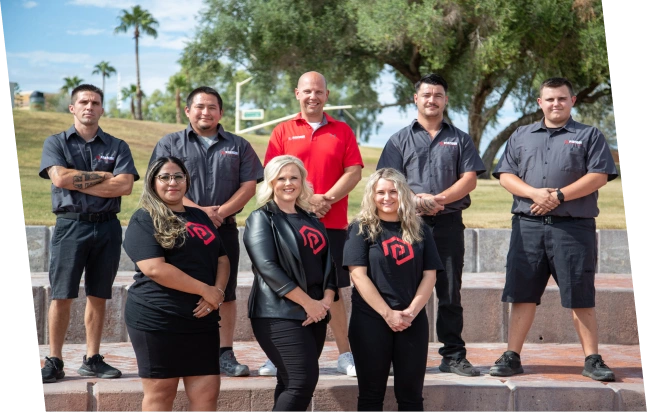A reliable air conditioning system keeps your home comfortable, especially during extreme temperatures. When it starts acting up, ignoring the warning signs can lead to costly repairs or a complete breakdown. Paying attention to performance changes helps prevent major issues.
Knowing when to schedule air conditioning maintenance ensures your system runs efficiently. Some signs seem minor, but they indicate underlying problems that need attention. Here are the key signs that your air conditioning system needs professional service before a small issue turns into a major headache.
1 – Weak airflow throughout your home
When your AC struggles to push out cool air, something is wrong. If certain rooms feel stuffy while others cool properly, airflow issues could be to blame. Blocked vents, clogged filters, or a failing blower motor could all contribute to the problem.
Weak airflow forces your system to work harder, increasing energy consumption. If replacing the filter doesn’t improve circulation, a professional should inspect the system. AC maintenance experts check for obstructions, motor issues, and duct leaks that reduce efficiency.
2 – Warm air blowing from the vents
If your air conditioning system pushes out warm air instead of cooling your home, there’s an issue. Check the thermostat settings first. Set it to cooling mode and adjust the temperature to a level lower than the current room temperature.
When the settings are correct, and the AC still blows warm air, refrigerant problems or compressor malfunctions could be the cause. Low refrigerant levels prevent the system from cooling properly, and a failing compressor affects the entire system. Scheduling air conditioning maintenance prevents further damage and restores cooling power.
Blocked airflow or a faulty thermostat sensor could also contribute to warm air circulation. Clogged air filters restrict airflow, forcing the system to work harder while failing to cool the space effectively. A malfunctioning thermostat sensor sends incorrect signals to the AC, preventing it from maintaining the right temperature.
Addressing these issues with regular AC maintenance ensures consistent cooling and prevents strain on the system.
3 – Strange noises coming from the unit
An AC system typically produces a low, steady hum. If it starts making unusual noises, pay attention. Grinding, squealing, or banging sounds signal mechanical issues that require immediate attention.
Squealing noises often indicate a belt issue, while grinding suggests motor problems. Banging could mean a loose or broken component inside the system. Ignoring these sounds leads to further damage, making repairs more expensive. A technician diagnoses the problem and prevents bigger issues with timely AC maintenance.
4 – Unpleasant odors from the vents
Strange smells coming from the vents mean something is wrong. A musty odor suggests mold or mildew buildup inside the ducts or unit. This impacts indoor air quality and poses health risks. A burning smell could indicate electrical issues, which need immediate inspection.
Mold growth inside the system spreads bacteria and allergens throughout your home. Professional cleaning during air conditioning maintenance eliminates odors, improves air quality, and keeps your system functioning efficiently.
5 – Rising energy bills with no explanation
An unexpected spike in energy bills often means your air conditioning system is working harder than necessary. When an AC runs inefficiently, it consumes more electricity to produce the same cooling effect.
Dirty filters, refrigerant leaks, and failing components all cause increased energy usage. Regular AC maintenance ensures your system operates at peak efficiency. A technician inspects coils, checks refrigerant levels, and cleans components to restore optimal performance.
6 – Frequent cycling on and off
Air conditioners cycle on and off to maintain a set temperature, but rapid or constant cycling signals a problem. Short cycling often results from thermostat issues, refrigerant imbalances, or electrical problems.
A system that turns on and off too frequently struggles to regulate temperature and wastes energy. Without prompt air conditioning maintenance, components wear out faster, leading to more expensive repairs.
7 – Ice buildup on the unit
If you notice ice forming on the air conditioning coils or refrigerant lines, something isn’t working correctly. Ice buildup happens when airflow is restricted, refrigerant levels are too low, or evaporator coils get too cold.
When ice covers the system, it disrupts cooling efficiency. Instead of trying to remove the ice manually, call an AC maintenance professional to diagnose the issue. A technician inspects airflow, refrigerant levels, and coil conditions to prevent long-term damage.
If ice forms on the evaporator coils, airflow may be blocked due to a dirty air filter or obstructed vents. Restricted airflow prevents warm air from reaching the coils, causing them to freeze instead of absorbing heat. Regular filter replacements and ensuring vents remain unblocked help maintain proper airflow and prevent ice accumulation.
Ignoring this issue forces the system to work harder, leading to more significant damage over time.
Refrigerant leaks also contribute to ice buildup. When refrigerant levels drop, the system loses its ability to absorb heat, causing condensation on the coils to freeze. Low refrigerant levels indicate a leak, which requires professional repair.
A certified AC maintenance technician detects leaks, refills refrigerant, and prevents further cooling inefficiencies that could shorten the lifespan of the unit.
8 – High indoor humidity levels
An AC system does more than cool the air — it also regulates humidity. If your home feels sticky or damp, the system isn’t removing moisture effectively.
A malfunctioning unit struggles to control humidity, leading to discomfort and potential mold growth.
An air conditioning maintenance check ensures the system is dehumidifying properly and prevents moisture-related problems.
If the AC runs constantly without lowering humidity, the system may be too large for the space. An oversized unit cools rooms quickly but doesn’t run long enough to remove moisture from the air. This leads to a damp environment where mold and mildew thrive.
A professional assesses the AC system to confirm it has the right size for effective temperature control and humidity removal.
Another cause of high humidity is a clogged condensate drain line. When moisture collects in the drain pan and doesn’t drain properly, excess humidity lingers in the air. A technician inspects and clears the drain line to restore proper moisture removal.
Routine air conditioning maintenance prevents blockages that contribute to excessive indoor humidity and potential water damage.

9 – Water leaks around the unit
Air conditioners produce condensation, but excessive water pooling near the unit signals trouble. Clogged drain lines, broken condensate pumps, or refrigerant leaks could be responsible.
Standing water around the system encourages mold growth and damages surrounding areas. A professional inspects drainage systems, clears blockages, and repairs leaks during routine AC maintenance.
Excess moisture near the AC unit may indicate frozen evaporator coils thawing too quickly. When coils freeze due to restricted airflow or low refrigerant levels, they eventually melt and overflow the drain pan. This can lead to water leaks that damage flooring, walls, and nearby furniture.
Addressing the root cause — whether it’s airflow obstruction, dirty filters, or refrigerant issues — prevents future water damage and keeps the system running efficiently.
10 – Thermostat problems
A faulty thermostat prevents an air conditioning system from operating correctly. If temperatures fluctuate or the AC doesn’t respond to settings, the thermostat could be miscalibrated or failing.
A technician tests thermostat accuracy and wiring connections. Upgrading to a programmable or smart thermostat improves efficiency and keeps your home comfortable.
Wiring issues or weak batteries also contribute to thermostat malfunctions. Loose or frayed wiring disrupts communication between the thermostat and the AC unit, causing inconsistent cooling cycles.
If the thermostat operates on batteries, weak power can result in inaccurate temperature readings. Checking connections and replacing batteries regularly keeps the thermostat functioning properly and prevents unnecessary AC disruptions.
11 – Don’t ignore AC warning signs
Catching small problems early prevents expensive repairs and extends the lifespan of your air conditioning system. Regular AC maintenance improves efficiency, lowers energy costs, and keeps your home comfortable year-round.
If your system shows any of these signs, schedule a professional inspection. A trained technician identifies issues, performs necessary repairs, and ensures your air conditioning maintenance is up to date. Stay ahead of breakdowns by keeping your AC in top shape before the heat sets in.
Ensure peak performance and reliability with Paragon Service Pros!
The skilled technicians at Paragon Service Pros deliver thorough HVAC maintenance to enhance efficiency, prevent costly repairs, and extend your system’s lifespan. Routine tune-ups reduce energy costs, minimize the risk of breakdowns, and keep your home comfortable in every season.
Avoid unnecessary repairs by staying ahead of potential issues. Schedule your HVAC service with Paragon Service Pros today and keep your system running at its best!



